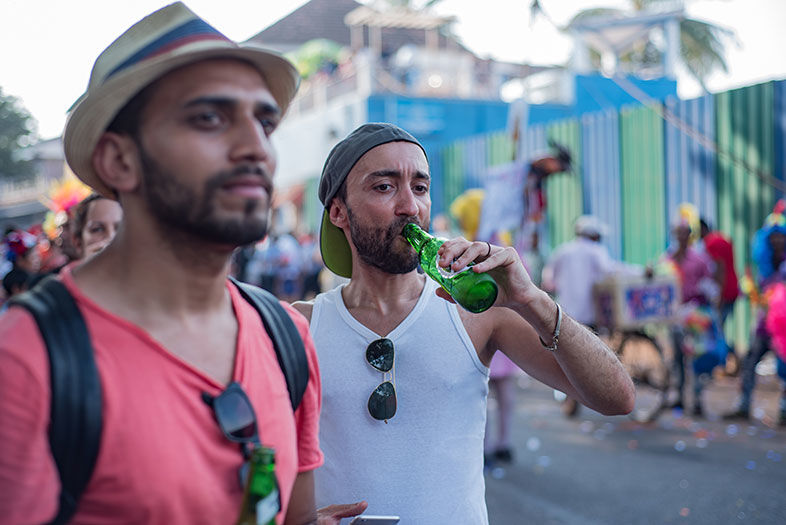With all the great beer that flows here in San Diego, and all the attention we give our fair city for its brewing prowess, it’s easy to get caught up in a kind of “beer bubble” where we forget that beers of all kinds play a major role in the lives and cultures of people all over the world. Once in a while, I think it’s good for us San Diego beer fanatics to get a little perspective on the beverage by considering what it means—and what it has meant—to others across the globe.
Beer lovers will be happy to know that beer is the most popular alcoholic beverage on the planet. It’s actually the third most-consumed beverage overall, after water and tea. Interesting fact: The biggest beer producers in the world are not the biggest per capita consumers of beer. Most of the world’s beer is produced by China, the United States, and Brazil. But which are the countries that actually drink the most beer? The answers may surprise you. The top five countries in per capita beer consumption are:
- Czech Republic (37.6 gallons per capita)
- Seychelles (30.3 gallons per capita)
- Austria (27.7 gallons per capita)
- Germany (27.7 gallons per capita)
- Namibia (27.1 gallons per capita)
Source: The Telegraph
Okay, Czech Republic, Germany, and Austria: I get it. But Namibia? How many of you got that one right?
You can probably tell from those statistics that beer plays very different roles in cultures and countries around the globe. In some places, it’s a central and ubiquitous part of everyday life. In other places, beer is eclipsed by more popular forms of alcohol. In still other countries, the attitudes and tastes for beer are rapidly evolving, even today. Here’s a crazy thing: Beer was actually banned in Iceland until 1989! (Coincidentally, that’s the same year the first Karl Strauss opened on Columbia Street downtown, effectively launching the craft beer era in San Diego.) Iceland’s beer ban stemmed from an initial movement in 1915 to get rid of beer, wine, and spirits. (It was widely believed that long, dark, cold winters and alcohol were not a good mix.) The ban on wine was lifted in 1922 and the ban on spirits ended in 1935, but—for some still unexplained reason—beer remained off limits in Iceland until 1989. Were Icelanders really happy with just wine and spirits for nearly 50 years before they decided to turn their taps back on?
In America, beer is the most-consumed alcoholic beverage, followed by hard cider, spirits, and then wine. (The U.S. is only 17th in the world in terms of per capita beer consumption—we drink an average of about 20 gallons of beer per person every year.) In Russia, beer has long played second fiddle to vodka, but in the past few years, beer has been on the rise. Traditionally, Russians also enjoy a beer-like alcoholic beverage, called kvass, which is made from fermenting old rye bread and water. Kvass began as a peasant creation (the fermentation and resulting alcohol evidently made it safer to drink than water), but it eventually took hold throughout Russian society, even though it’s a watery, less carbonated near-beer beverage. Today, kvass is commonly sold street-side from big yellow tanks and is marketed mostly as a “health” drink because it’s low in alcohol and it contains lots of vitamin B.

Around the World in Beer
People buy a bottle of kvass from a yellow barrel in Russia.
In Central and South America, a fermented grain beverage called chicha is the traditional version of what we think of as beer. Chicha most commonly utilizes germinated maize, which is boiled into a wort and fermented in large vessels. The process, which is very similar to brewing malted barley beer, has been practiced in Central and South America for thousands of years. Today, chicha is less common throughout the continent, but remains very popular in Peru, Ecuador, Bolivia, and Colombia. Many people produce various versions of chicha, each with varying levels of fermentation and resulting alcohol. Non-fermented chicha is usually reserved for children and the most highly alcoholic batches are served only to men.
The beer-like beverage of choice in many African countries is sorghum beer; it’s one of the most popular drinks in South Africa, Nigeria, and Cameroon, among other places. Sorghum beer normally has a cloudy, pinkish-brown appearance, and a sour, fruity taste. Unlike other beer, it’s low in carbohydrates, rich in protein, and its alcohol content generally varies between 1% and 8%. Sorghum beer is easy to make and can be brewed at home using sorghum malt instead of barley grain. The resulting beverage also happens to be naturally gluten free. In Cameroon, sorghum beer is most commonly known as bil-bil, in Nigeria it’s called burukutu, in East Africa it’s pombe, and in Northern Sotho it’s known as bjala bja setso.
Evidently, Anheuser-Busch tried to market sorghum beer in the United States at one point—the brand was called Redbridge—and a Milwaukee brewery called Lakefront tried to sell a brand called New Grist. Needless to say, sorghum beer did not take America by storm. American tastes remained more loyal to the traditional mass-produced lager-like styles that still dominate the big beer landscape today.
If you look hard enough, you’ll likely find some form of fermented grain-based beverage at the center of just about every culture on earth. I think there’s something basically comforting about that. It makes me feel as if—every time I take a sip of some delicious beer—I’m acknowledging a deeply held human need to take part in a tradition that exalts the magical powers of fermentation. I believe we should all celebrate that basic human need whenever we can—after all, we don’t want to deny our humanity!

Around the World in Beer
Men enjoying beer during the grand parade of Goa Carnival in India. | Photo: Shutterstock














